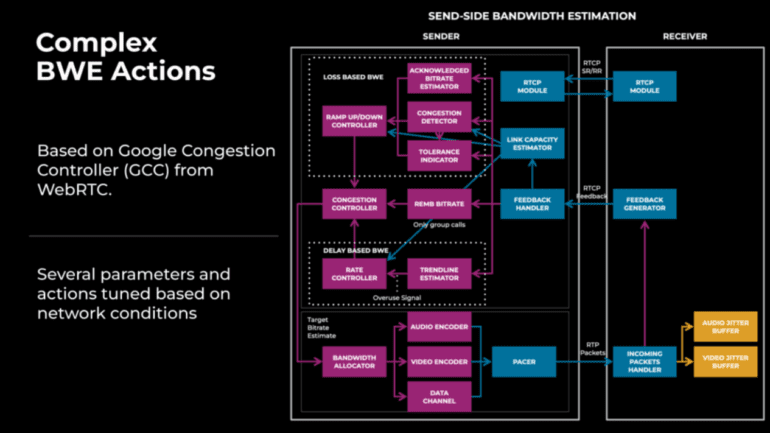- Meta unveils ML solution for bandwidth estimation and congestion control in real-time communication.
- Traditional methods like Google Congestion Controller lack adaptability to diverse network conditions.
- Meta’s approach replaces manual rules with ML, leveraging time series data for parameter optimization.
- Components include offline ML model training and parameter adjustment for dynamic network adaptation.
- ML model improves network resilience by detecting packet loss and preemptively managing congestion.
- Experimental results show significant enhancements in reliability and quality metrics across various network types.
Main AI News:
Innovators at Meta have unveiled a revolutionary machine learning (ML) solution designed to tackle the complexities of bandwidth estimation (BWE) and congestion control within real-time communication (RTC) across the Meta app ecosystem. Traditional methods, exemplified by WebRTC’s Google Congestion Controller (GCC), have long relied on manually adjusted parameters, resulting in convoluted systems ill-equipped to handle the dynamic nature of modern network environments. Striking a balance between quality and reliability has proven elusive, with enhancements in one area often coming at the expense of another, complicating efforts to optimize user experiences across diverse network landscapes.
Meta’s current BWE framework, built upon GCC, operates on a foundation of parameter adjustments aimed at enhancing performance. However, this approach has spawned a labyrinthine network of interdependent actions and parameters, hampering adaptability to fluctuating network conditions. Meta’s novel solution takes a holistic approach to network optimization, spanning multiple layers, including BWE, network resilience, and transport protocols. The strategy revolves around replacing cumbersome manual rules with a streamlined alternative, harnessing time series data for offline parameter refinement and comprehensive network analysis.
At the heart of Meta’s ML-driven initiative lie two pivotal components: offline ML model training and parameter optimization. The model training phase capitalizes on time series data gleaned from live calls and simulated scenarios to classify diverse network conditions and fine-tune associated parameters. Leveraging a sophisticated architecture comprising Long Short-Term Memory (LSTM) layers for temporal data processing and dense layers for non-temporal data, Meta achieves precise modeling of network dynamics. For instance, the ML model adeptly identifies instances of random packet loss and dynamically adjusts BWE parameters to bolster tolerance thresholds, thereby fortifying network resilience. Moreover, the model’s predictive capabilities enable preemptive congestion management in low-bandwidth scenarios, mitigating potential video freezes and connection disruptions.
Experimental findings underscore the efficacy of Meta’s ML-driven approach, showcasing marked enhancements in reliability and quality metrics across heterogeneous network environments. Notably, congestion anticipation curtails connection drop rates, fostering an uninterrupted user experience, while BWE optimization elevates video quality and diminishes freeze occurrences. These outcomes underscore the superiority of ML-driven methodologies vis-à-vis conventional manual rules, particularly in their capacity to target, monitor, and adapt to evolving network dynamics with unprecedented efficiency.
Conclusion:
Meta’s introduction of a machine learning-based approach for network optimization signifies a paradigm shift in the industry. By replacing manual parameter tuning with sophisticated ML models, Meta is poised to revolutionize how companies approach bandwidth estimation and congestion control in real-time communication. This innovation promises to enhance user experiences across diverse network landscapes and underscores the growing importance of AI-driven solutions in network management. Businesses in the market must adapt to this trend to remain competitive and meet the evolving demands of users in an increasingly connected world.

